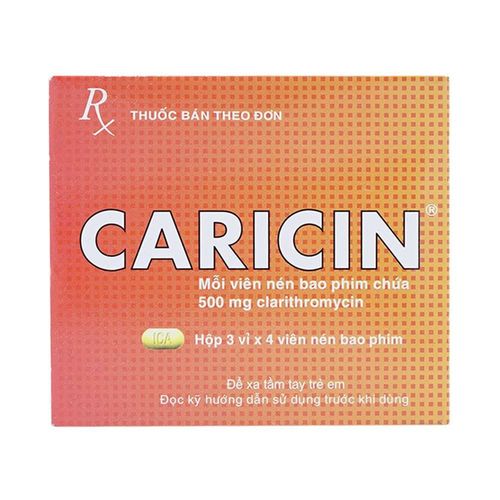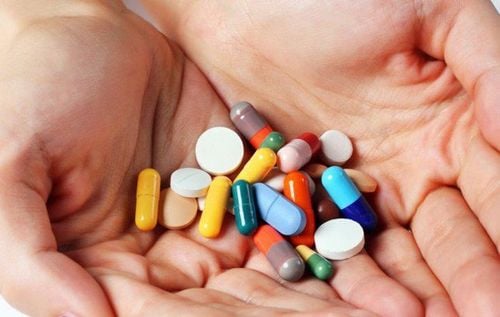This is an automatically translated article.
Urinary tract pathogens can attack many organs such as the urethra, bladder, ureters or kidneys. If not treated with the right medications, UTIs can lead to a number of dangerous health complications. So what are the medications for urinary tract infections?
1. An overview of urinary tract infections
Urinary tract infection is an infection of the organs of the urinary system such as the kidneys, ureters, bladder and urethra. The causative agents of the disease are mainly bacterial strains, of which the typical and most common is E.coli. Most pathogenic bacteria enter the urinary tract by upstream from nearby areas such as around the rectum and anus, then attack the urethra and spread to the upper organs such as the bladder and urinary tract. ureters and kidneys.
The main manifestations of this disease are urinary disorders, including painful urination, frequent urination, blood in urine, frequent urination... Besides the health effects, patients often feel extremely uncomfortable. discomfort, thereby significantly affecting daily activities. More dangerously, patients are not using the right drugs to treat urinary tract infections, which can lead to many dangerous health complications.
Currently, the simplest and most effective UTI treatment regimen is mainly using antibiotics. However, the choice of antibiotics for urinary tract infections must adhere to some principles of a specialist. Patients absolutely do not arbitrarily choose without being examined and consulted by a doctor.
Principles of choosing antibiotics for urinary tract infections:
Choosing antibiotics according to the causative agent: The doctor will take appropriate measures to determine which bacteria cause urinary tract infections, from which to choose choose antibiotics with suitable antibacterial spectrum; Selection of antibiotics for urinary tract infections is based on the complexity of each case; The type of antibiotic must be suitable for the bacterial resistance status; Select appropriate treatment conditions of each patient.
2. Antibiotics for urinary tract infections
2.1. Sulfamide derivative antibiotics Sulfamide is a common antibiotic for urinary tract infections, essentially a synthetic antibiotic, with a white powder texture, difficult to dissolve in water but easily soluble in serum and bile. Antibiotics of this group possess bacteriostatic properties through inhibition of dihydrofolate synthetase, an enzyme involved in the biosynthesis of folic acid.
The antibacterial spectrum of the Sulfamide group is very broad, including gram-positive and gram-negative cocci and bacilli. However, the biggest drawback is the relatively high rate of drug resistance (including cross-resistance among sulfamides). Therefore, sulfamid should be combined with resistance groups in antibiotic prescriptions for urinary tract infections.
Classification of sulphonamide antibiotics:
Fast absorption, rapid elimination; Very little absorption type; Slow elimination; Local use. In particular, the fast-absorbing, fast-eliminating sulfamide is commonly indicated in the treatment of blood-borne infections such as urinary tract infections.
Unexpected side effects when using Sulfamide antibiotic group:
Digestive disorders: Nausea, vomiting, diarrhea...; Renal effects, hematuria, anuria or tubulointerstitial nephritis; Effects on the skin: Blisters, blisters, peeling skin...; Decrease in white blood cells, platelets, marrow failure...; Effects on liver function, jaundice, poisoning. Contraindications of Sulfamid antibiotics:
Patients with insulin-dependent diabetes mellitus (type 1); Severe kidney or liver failure; Hypersensitivity to sulphonamides; Pregnant and lactating women; Minors and under 3 years old... 2.2. Cephalosporin antibiotics Cephalosporins are a group of semi-synthetic antibiotics with broad bactericidal spectrum, mechanism of action similar to penicillin. The mechanism of action of Cephalosporin antibiotics is to inhibit bacterial cell biosynthesis, so it often appears in the prescription of drugs for treating urinary tract infections by doctors.
Based on antibacterial spectrum, cephalosporin antibiotics are classified into 5 generations from 1 to 5. The spectrum of action of the former generation is stronger on gram-positive bacteria, while the following generations are dominant on gram-negative bacteria.
Undesirable effects of Cephalosporin when treating urinary tract infections:
Allergic reactions with manifestations of skin rash, urticaria, itching...; Digestive disorders such as colitis, pseudomembranous colitis, diarrhea, nausea, vomiting...; Hematological disorders such as decreased white blood cell or platelet count, anemia, hemolysis...; Pain at the injection site; Thrombophlebitis; Superinfection with fungi in the oral cavity and/or vagina... Contraindications of Cephalosporin antibiotics:
History of allergy to penicillin; Injections into or near arteries and nerves; Combination of 4th generation Cephalosporin with intravenous calcium solution; Neonatal hyperbilirubinemia; Premature babies. 2.3. Quinolone antibiotics This group of antibiotics for urinary tract infections is completely synthetic. Quinolone most classic nalidixic acid, later generations added fluoride and extended antibacterial spectrum.
Quinolone antibiotics act through their ability to inhibit bacterial DNA and RNA biosynthesis, thereby acting as bactericidal. Quinolones are currently classified into 4 generations with the following characteristics:
Quinolones generation 1: Indicated in urinary infections caused by gram-negative bacilli, except for Pseudomonas aeruginosa. The route of administration is oral, the dose is 2g/day divided into 2 times; Quinolones of the remaining generations: Indicated as antibiotics for urinary tract infections or other diseases such as pneumonia, bacteremia, meningitis, bone infections... Similar to other antibiotics, Quinolones in the prescription for urinary tract infections also cause the following side effects:
Nausea, vomiting, loose diarrhea, epigastric pain, severe stomach...; Sensitive reaction to light; Allergies such as redness, itching, rash, blistering skin...; Dizziness, lightheadedness, headache, seizures, or hallucinations; Swollen joints, muscle aches; Damage to cartilage tissue (especially in young children); Apnea during intravenous infusion Contraindications of antibiotics for urinary tract infections Quinolone:
Caution in cases of suspected or confirmed central nervous system disease; Current or regular treatment with glucocorticoids; Alcoholism; Pregnant women; Children under 16 years old...
3. Other drugs for urinary tract infections
3.1. Midasol Midasol is a product that supports the treatment of urinary tract infection symptoms, especially inflammation, pain, and swelling of the lower urinary tract. This product only has a supportive effect in the case of uncomplicated urinary tract infections.
The specific dose of Midasol urinary tract infection is as follows:
Adults: 6 tablets/day, divided into 2-3 doses after eating 30-40 minutes; Children: Dosage as prescribed by the doctor. 3.2. Domitazol Domitazol is one of the effective drugs to treat urinary tract infections in the absence of serious complications.
Specific dose of Domitazol depends on each subject and disease condition:
Children: As indicated by a specialist; Adults: 6 tablets/day, divided into 3 doses. This urinary tract infection drug is contraindicated for use in pregnant women or those with confirmed kidney disease. At the same time, during the use of Domitazol, the patient should abstain from certain foods according to the instructions of the doctor for the drug to promote the best effect
3.3. TanaMisolBlue TanaMisolBlue has the effect of supporting the treatment of symptoms relatively effectively when urinary infections have not been complicated.
Dosage:
Children: Strictly follow the doctor's prescription in each specific disease case; Adults: Take 2-3 tablets/time, 3 times/day, after meals. Do not use TanaMisolBlue in people with a history of kidney disease, pregnant women and people with known allergies to the ingredients contained in the drug.
3.4. Miclacol Blue F Miclacol Blue F is of natural origin, has a relatively good supportive effect against infections and fungal infections. This is one of the drugs for treating lower urinary tract infections without serious complications with a high level of safety and compatibility.
Dosage in adults is 6 tablets / day, divided into 3 times, taken after eating about 30-40 minutes.
3.5. Mictasol Bleu Mictasol Bleu is a product with antiseptic and antibacterial effects, so it is often indicated for supportive treatment of complicated urinary tract infections. The effects of the drug include pain relief, swelling reduction, and resistance to disease-causing bacteria. In some severe cases, the doctor may prescribe a combination of Mictasol Bleu with an antibiotic to treat urinary tract infections.
Dosage: 6-9 tablets/day, divided equally into 3 times/day.
The above are drugs used in the treatment of urinary tract infections. It is best when you intend to use any medicine, you should consult a specialist for the appropriate indication.
Please dial HOTLINE for more information or register for an appointment HERE. Download MyVinmec app to make appointments faster and to manage your bookings easily.













